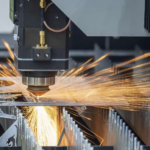Introduction
Sheet metal fabrication is an essential process in modern manufacturing, playing a critical role in creating components used across industries like construction, automotive, aerospace, and electronics. Its versatility, durability, and cost-efficiency make it a fundamental method for producing high-quality products. In this article, we’ll break down what sheet metal fabrication is, explore its techniques, and highlight the industries that rely heavily on this craft.
What Is Sheet Metal Fabrication?
Sheet metal fabrication involves transforming flat sheets of metal into desired shapes and structures through various processes, including cutting, bending, and assembling. Common materials used in fabrication include steel, aluminum, copper, and stainless steel, each chosen based on the project’s requirements, such as strength, conductivity, or corrosion resistance.
The Key Processes in Sheet Metal Fabrication
- Cutting
Cutting is the initial step, where large sheets are trimmed down to size or given intricate shapes. Methods include:- Laser Cutting: High-precision cuts for complex designs, ideal for detailed work.
- Plasma Cutting: Efficient for thick metals and larger projects.
- Waterjet Cutting: Uses high-pressure water for cutting, especially useful for heat-sensitive materials.
- Bending
After cutting, the metal is shaped using press brakes, rollers, or manual techniques. Bending transforms flat sheets into three-dimensional structures like brackets, enclosures, and frames. - Forming
Forming involves stretching or compressing the metal to achieve specific contours. Techniques like roll forming and deep drawing are used to create components like pipes and automotive parts. - Welding and Assembly
In the final stage, pieces are joined together through welding, riveting, or adhesives to complete the fabrication. Precision welding ensures strong, long-lasting joints.
Advanced Technology in Fabrication
Modern sheet metal fabrication benefits from advanced technology like CNC (Computer Numerical Control) machines and CAD (Computer-Aided Design) software. These innovations allow for:
- Increased Precision: Achieving intricate designs with minimal errors.
- Efficiency: Faster production with reduced waste.
- Customization: Tailored solutions for specific industries and projects.
Automation and robotics are also enhancing productivity, making it possible to handle large-scale manufacturing with consistent quality.
Industries That Rely on Sheet Metal Fabrication
- Automotive
Sheet metal is crucial for manufacturing vehicle bodies, panels, and structural components. The ability to create lightweight yet strong parts helps improve fuel efficiency and safety. - Construction
From HVAC systems to roofing and structural frameworks, sheet metal fabrication supports the infrastructure of modern buildings. - Aerospace
Aircraft require high-strength, lightweight metals to ensure performance and safety. Precision fabrication techniques are critical for components like fuselage parts and engine casings. - Electronics
Sheet metal enclosures protect sensitive electronics, ensuring durability and proper heat dissipation. - Medical Equipment
Fabricated metal components are used in surgical tools, medical devices, and hospital equipment, where precision and hygiene are paramount.
Benefits of Sheet Metal Fabrication
- Versatility: Suitable for a wide range of applications and industries.
- Durability: Metals offer strength and longevity.
- Cost-Effectiveness: Efficient production methods reduce costs for large batches.
- Customization: Adaptable to unique design requirements.
Conclusion
Sheet metal fabrication continues to drive innovation in manufacturing. As technology evolves, the process becomes more precise, efficient, and adaptable, making it indispensable in shaping the products we use every day. Whether it’s for building skyscrapers or crafting intricate electronic components, sheet metal fabrication remains a cornerstone of industrial progress.

